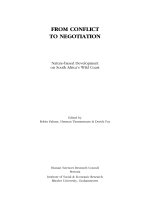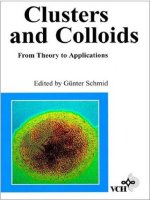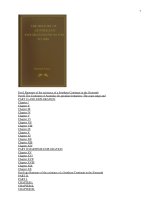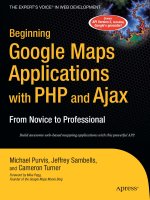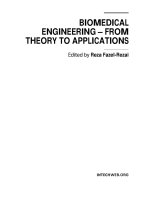Clusters and Colloids From Theory to Applications ppt
Bạn đang xem bản rút gọn của tài liệu. Xem và tải ngay bản đầy đủ của tài liệu tại đây (32.7 MB, 571 trang )
Clusters
and
Colloids
From
Theory
to
Applications
Edited
by
Gunter Schmid
8
VCH Verlagsgesellschaft mbH, D-69451 Weinheim (Federal Republic
of
Germany), 1994
Distribution:
VCH,
PO.
Box 101161, D-69451 Weinheim, Federal Republic
of
Germany
Switzerland: VCH,
P.O.
Box, CH-4020 Basel, Switzerland
United Kingdom and Ireland: VCH,
8
Wellington Court, Cambridge CB1
MZ,
United Kingdom
USA and Canada: VCH, 220 East 23rd Street, New York, NY 100104606, USA
Japan: VCH, Eikow Building, 10-9 Hongo 1-chome, Bunkyo-ku, 'lbkyo lU, Japan
ISBN 3-527-29043-5 (VCH, Weinheim) ISBN 1-56081-753-4 (VCH, New York)
Clusters
and
Colloids
From
Theory
to
Applications
Edited
by
Gunter Schmid
VCH
4b
Weinheim
New
York
Base1 Cambridge
Tokyo
Prof. Dr. Giinter Schmid
Institut fiir Anorganische Chemie
Universitit GH Essen
UniversititsstraSe 5-7
D-45117 Essen
Federal Republic
of
Germany
This
book was carefully produced. Nevertheless, authors, editor and publisher do not warrant the
information contained therein to be free of errors. Readers
are
advised to keep in mind that
statements, data, illustrations, procedural details or other items may inadvertently be inaccurate.
Published jointly by
VCH Verlagsgesellschaft mbH, Weinheim (Federal Republic
of
Germany)
VCH Publishers, Inc., New York, NY (USA)
Editorial Directors:
Dr.
Thomas Mager and
Dr.
Thomas Kellersohn
Production Manager: Elke Littmann
The cover shows a high resolution microscopic image
of
a single gold colloid (about llx
l3
nm), protected by a
shell
of
P(rn-C,H,SO,Na) ligands. The picture has kindly been provided by Prof.
J.
0.
Bovin and A. Carlsson,
University
of
Lund, which is gratefully acknowledged.
Library
of
Congress Card No. applied for.
A
catalogue record for this book is available from the British Library.
Deutsche Bibliothek Cataloguing-in-Publication Data:
Clusters and colloids
:
from theory to applications
I
ed.
by GIinter Schmid.
-
Weinheim
;
New York
;
Basel
;
Cambridge
;
Tokyo
:
VCH, 1994
ISBN 3-527-29043-5 (Weinheim
)
ISBN 1-56081-753-4 (New York)
NE: Schmid, Giinter [Hrsg.]
0
VCH Verlagsgesellschaft mbH, D-69451 Weinheim (Federal Republic of Germany), 1994
Printed
on
acid-free and chlorine-free paper.
All
rights reserved (including those of translation into other languages). No part of this book may be
reproduced in any form
-
by photoprinting, microfilm, or any other means
-
nor transmitted or translated
into a machine language without written permission from the publishers. Registered names, trademarks,
etc. used in this book, even when not specifically marked as such, are not to be considered unprotected
by law.
Composition: Hagedornsatz GmbH, D-68519 Viernheim. Printing: Druckhaus Diesbach, D-69442 Wein-
heim. Bookbinding:
J.
Schttffer GmbH, D-67269 Grtinstadt.
Printed in the Federal Republic
of
Germany.
Contents
1
2
2.1
2.2
2.2.1
2.2.2
2.2.3
2.3
2.3.1
2.3.2
2.3.2.1
2.3.2.2
2.3.2.3
2.3.2.4
2.3.2.5
2.3.2.6
2.3.3
2.3.4
2.3.5
2.3.6
2.3.6.1
2.3.6.2
2.4
2.4.1
2.4.2
2.4.2.1
2.4.2.2
2.4.2.3
2.4.3
2.4.3.1
General Introduction
(G
.
Schmid)
1
Electronic Structure
of
Metal Clusters and Cluster Compounds
Introduction
5
6
(N
.
Rosch and
G
.
Pacchioni)
5
The Description of the Clusters’ Electronic Structure
Wave Function Based Methods
7
Density Functional Methods
10
Simplified Methods
11
Structure and Properties of Naked Clusters
The Theoretical Description of Metal Clusters
Structure. Bonding. and Stability
13
Geometrical Structures
13
The Jellium Model
17
Fluxionality
19
Stability and Fragmentation
19
Bond Lengths
21
Electron Delocalization in Clusters
22
Ionization Potentials and Electron Affinities
23
Electronic States. “Band Structure”. and Band Gap
25
Optical Responses
28
Clusters in External Fields
31
Magnetic Behavior
31
Electric Polarizability
32
Structure and Properties of Ligated Clusters
33
The Metal-Ligand Interactions
33
Structures and Bond Lengths
Geometrical Structures
36
Metal-Metal Bond Lengths
43
The Ligand Polyhedron
47
Topological Relationships and Simplified Bonding Models
49
The Effective Atomic Number (EAN) Rule
49
12
13
36
VI
Contents
2.4.3.2
2.4.3.3
2.4.3.4
2.4.3.5
2.4.4
2.4.4.1
2.4.4.2
2.4.4.3
2.4.4.4
2.4.4.5
2.4.4.6
2.4.5
2.4.5.1
2.4.5.2
2.4.5.3
2.4.5.4
2.4.5.5
2.4.5.6
2.4.5.7
The Polyhedral Skeletal Electron Pair (PSEP) Model
50
Topological Electron Counting
(TEC)
51
Electron Counting Based on the Extended Huckel Approach
51
Clusters Stabilized by s-s Interactions: A Unified View
53
Quantum Chemistry of Organometallic Clusters:
A Deeper
Look
into the Bonding
56
Semiempirical Calculations
56
Limitations of Simplified Approaches
56
Bare Versus Ligated Clusters: The Effect
of
the Ligands
57
Ligand-Field Effects in Clusters
60
The Strength of the Metal-Metal Bonds
61
Clusters with Interstitial Atoms
62
Physical Measurements and Chemical Bonding
64
Photoelectron Spectroscopy
64
Optical Spectroscopy
68
Magnetic Susceptibility Measurements
69
ESR Spectra
72
NMRSpectra
74
Redox Properties
75
Specific Heat
75
2.5
Conclusions
76
2.5.1
The Role of Theory in Clusters Research
76
2.5.2
On the Analogy between Metal Clusters and Surfaces
78
References
80
3
Clusters
in
Ligand
Shells
89
3.1
Introduction
(0
. Fenske.
G
.
Longoni and
G
.
Schmid)
89
3.2
3.2.1
3.2.2
3.2.3
3.2.4
3.2.4.1
3.2.4.2
3.2.4.3
3.2.4.4
3.2.5
3.2.5.1
Low-valent Organometallic Clusters
(G
.
Longoni and
M
.
C
.
Iapalucci)
91
Interplay Between Electronic and Steric Factors in the Growth
of Transition Metal Molecular Clusters in Ligand Shells
91
Bonding and Spectroscopic Behavior
of
Carbon Monoxide
95
Stereochemical Non-rigidity of Clusters in Ligand Shells
99
Homo- and Heterometallic Transition Metal Clusters
105
Synthesis
of
High Nuclearity Clusters by Ligand Elimination
107
Synthesis
of
Higher Nuclearity Clusters by Elimination of Metal
Fragments
112
Synthesis
of
Higher Nuclearity Clusters by Redox Processes
113
Structural Features of Homo- and Heterometallic Clusters
121
Transition Metal Clusters Containing Main Group Elements
132
Overview
of
the Synthetic Methods and Spectroscopic
Characteristics of Ransition Metal Clusters Containing Interstitial
or Exposed Main Group Elements
135
Contents
VII
3.2.5.2
3.2.5.3
3.2.6
3.2.7
3.3
3.3.1
3.3.2
3.3.3
3.3.3.1
3.3.3.2
3.3.3.3
3.3.3.4
3.3.3.5
3.3.3.6
3.3.3.7
3.3.4
3.4
3.4.1
3.4.1.1
3.4.1.2
3.4.1.3
3.4.2
3.4.3
3.4.3.1
3.4.3.2
3.4.4
3.4.5
4
4.1
4.1.1
Overview
of
the Synthetic Methods of Mixed Clusters and Main
Group Element Clusters Containing Transition Metal Atoms
147
Structural Characteristics
of
Transition Metal Clusters Containing
Interstitial or Exposed Main Group Elements or Elemental Organic
Clusters of Clusters and Beyond
154
Conclusion
165
References
166
Fragments
148
Metal Rich Large Clusters with
P
and N Ligands
(G
.
Schmid)
The Characterization
of
Large Clusters by High Resolution
Transmission Electron Microscopy (HRTEM) and by Scanning
Tunneling Microscopy
(STM)
Physical Properties
Nuclear Magnetic Resonance (NMR)
Extended X-ray Absorption Fine Structure
(EXAFS)
lg7Au Mossbauer Spectroscopy
of
AuSS Clusters
Photoelectron Spectroscopy (XPS)
UV-Visible Spectroscopy
Conductivity Measurements and Impedance Spectroscopy
(IS)
Chemical Properties
References
Synthetic Aspects
Magnetism
.
.
178
.
.178
.
.183
.
.188
.
.188
.
.192
.
.193
.
.194
.
.197
.
.197
. .
199
.
.205
.
.208
Transition Metal Clusters with Bridging Main Group Elements
Transition Metal Clusters with
E
and ER Bridging Ligands
Clusters with PR and P Bridging Ligands
212
Clusters with As and Sb as Bridging Ligands
223
Nitrogen Bridged Clusters
227
Clusters with ER Bridging Ligands (E
=
S.
Se.
Te;
231
Clusters with
E
Bridging Ligands (E
=
S.
Se.
Te)
232
S
and Se Bridged Clusters
of
Cobalt and Nickel having PR, Ligands
Palladium Clusters with
S.
Se. and
Te
Bridges
254
Copper Clusters with Se and
Te
Ligands
263
Chalcogen Bridged Transition Metal Clusters with
$.Cyclopentadienyl. k.Ally1. and CO Ligands
275
References
289
(D
.
Fenske)
212
(E
=
N. P. As. Sb; R
=
Organic Group)
212
R
=
Organic Group)
(R
=
Organic Group)
233
Clusters in
Cages
(S
.
Kawi and
B
.
C
.
Gates)
299
Introduction
299
Clusters and Cages
299
VIII
Contents
4.1.2
4.1.3
4.1.4
4.2
4.2.1
4.2.1.1
4.2.1.2
4.2.1.3
4.2.1.4
4.2.2
4.2.2.1
4.2.2.2
4.2.2.3
4.2.2.4
4.2.2.5
4.2.2.6
4.2.2.7
4.2.2.8
4.2.2.9
4.2.2.10
4.2.3
4.2.3.1
4.2.3.2
4.2.3.3
4.2.3.4
4.2.3.5
4.2.3.6
4.2.4
4.2.4.1
4.2.4.2
4.2.4.3
4.2.4.4
4.2.5
4.3
4.3.1
4.3.1.1
4.3.1.2
4.3.1.3
4.3.1.4
4.3.2
4.3.2.1
4.3.2.2
Opportunities Offered by Cages: Cluster Confinement and Size
Limitation
299
Materials with Cage Structures: Zeolites
300
Properties of Clusters in Cages
304
Metal Carbonyl Clusters in Zeolites
306
Synthesis
306
Sublimation of Polynuclear Metal Carbonyl Precursors
Ship-in-a-Bottle Syntheses
307
Sorption
of
Metal Carbonyl Complexes
Complexes
309
Characterization Techniques
313
Chemical Methods
316
Temperature-Programmed Desorption
317
Infrared Spectroscopy
317
Nuclear Magnetic Resonance (NMR) Spectroscopy
320
X-ray Diffraction and Scattering
324
Ultraviolet-Visible Spectroscopy
324
Electron Paramagnetic Resonance (EPR) Spectroscopy
324
X-ray Photoelectron Spectroscopy (XPS)
325
Raman Spectroscopy
325
Reactivity of Metal Carbonyl Clusters in Zeolites
325
Formation
of
Lewis
Acid-Base Adducts
325
Formation of Brbnsted Acid-Base Adducts
327
Ion Pairing
328
Nucleophilic Attack at CO Ligands
329
Disproportionation Reactions
329
Oxidative Fragmentation and Reductive Condensation
Catalysis
330
CO
Hydrogenation
331
Alkene Hydroformylation
334
Water Gas Shift Reaction
334
Summary
335
Uniqueness of Zeolite Cages as Media for Cluster Synthesis and
Stabilization
335
Metal Cluster in Zeolites
336
Synthesis
336
Decomposition of Metal Carbonyl Clusters
337
Reduction
of
Exchange
Ions
338
Solution Phase Metal Atom Techniques
340
Impregnation with Salt Solutions
340
Characterization Techniques
340
EXAFS
Spectroscopy
340
X-ray Diffraction and Scattering
341
306
308
Reductive Carbonylation
of
Mononuclear Metal Carbonyl
Extended X-ray Absorption Fine Structure (EXAFS) Spectroscopy
.
321
329
Contents
IX
4.3.2.3 Transmission Electron Microscopy (TEM)
342
4.3.2.4 Chemical Probes
343
4.3.2.6 X-ray Absorption Near Edge Spectroscopy (XANES)
345
4.3.2.7 Far Infrared Spectroscopy
345
4.3.2.9 X-ray Photoelectron Spectroscopy (XPS)
346
4.3.2.10 Other Physical Techniques
346
4.3.2.11 Summary
346
4.3.3 Reactivities
346
4.3.3.1 Redispersion of Metal Clusters by Oxidative Fragmentation
347
4.3.3.2 Agglomeration of Metal Clusters in the Presence of CO
347
4.3.3.3 Reversible Recarbonylation of Molecular Metal Clusters
348
4.3.3.4 Adduct Formation of Metal Particles and Protons
349
4.3.3.5 Effects of Sulfur on Encaged Pt Clusters
350
4.3.4 Modification of Electronic Structure
351
4.3.5 Catalysis
351
4.4
Synthesis and Characterization
of
Bimetallic Clusters in Zeolites
.
.
352
4.4.1 Decomposition of Metal Carbonyls on Reduced Metals
353
4.4.2 Decomposition of Bimetallic Carbonyl Clusters
353
4.4.3 Reduction of Ion Exchanged Metal Complexes
354
4.4.4 Reductive Carbonylation of Mixed Metal Complexes
354
4.5 Metal Ion Clusters in Zeolites
354
4.6 Semiconductor Clusters in Zeolite Cages
355
4.6.1 Synthesis
356
4.6.1.1 Ion Exchange
356
4.6.1.2 Organometallic (Metallorganic) Chemical Vapor Deposition
(MOCVD)
356
4.6.2 Characterization
357
4.6.2.1 Metal Sulfides
357
4.6.2.2 Metal Oxides
359
4.6.2.3 Metal Selenides
361
4.6.2.4 Selenide Chains and Rings
361
4.7 Prospects: Clusters in Fullerenes
362
4.8 Summary and Evaluation
362
References
365
4.3.2.5 NMR Spectroscopy
344
4.3.2.8 Sorption of Gases
345
5
Discrete and Condensed Tkansition Metal Clusters in Solids
(A
.
Simon)
373
5.1 Introduction
373
5.2 Empty Octahedral Metal Clusters
375
5.3 Clusters Containing Interstitial Atoms
385
X
Contents
5.4
5.5
5.6
5.7
5.8
5.8.1
5.8.2
5.8.3
5.8.4
5.8.5
5.9
6
6.1
6.1.1
6.1.2
6.1.3
6.2
6.2.1
6.2.1.1
6.2.1.2
6.2.2
6.2.2.1
6.2.2.2
6.2.2.3
6.2.2.4
6.2.2.5
6.2.2.6
6.2.2.7
6.2.2.8
6.2.3
6.3
6.3.1
6.3.2
6.3.3
6.3.3.1
6.3.3.2
Condensed Empty Clusters
395
Condensed Clusters with Interstitials
417
Condensed Non-octahedral Clusters
432
Bare Metal Clusters
435
Structure Property Relations
440
Superconductivity in Chevrel Phases
443
Magnetic OrdedDisorder in Category (ii) Lanthanide Hydride
Halides
445
448
450
Closing Remark
452
References
452
Spin Crossover 'Iiansition in a Category (i) Cluster
441
Superconductivity in Rare Earth Carbide Halides
Alkali Metal Suboxides as IR Emitting Photocathodes
The Chemistry
of
lfsnsition Metal Colloids
(J
.
S
.
Bradley)
459
Introduction
459
Some Definitions
459
Historical Aspects
460
Current Interest
463
Preparative Methods
464
General Considerations
464
Generation of Metal Particles
464
Synthetic Methods for the Preparation
of
Colloidal Transition
Metals
469
Salt Reduction
469
Stabilization of Colloidal Metal Particles in
Liquids
465
Thermal Decomposition and Photochemical Methods
473
Ligand Reduction and Displacement from Organometallics
476
Preparation of Colloidal Metals in Constrained Environments
481
Metal Vapor Synthesis
477
Bimetallic Colloids
485
Ligand Stabilized Metal Colloids
487
A
Comment on Ligand Stabilized Giant Molecular Clusters and
Colloidal Metal Particles
489
Summary of Synthetic Methods
490
Particle Size and Distribution
491
Structures
495
Electron Microscopy
495
X-ray Diffraction
499
Structural Properties of Colloidal Transition Metals
490
Composition
493
Contents
XI
6.3.3.3
6.3.3.4
6.4
6.4.1
6.4.2
6.4.3
6.4.3.1
6.4.3.2
6.4.4
6.4.4.1
6.4.4.2
6.4.5
6.5
6.5.1
6.5.2
6.5.3
6.5.4
6.5.5
6.5.6
6.5.7
6.5.7.1
6.5.7.2
6.5.8
6.6
7
Index
.
EXAFS
499
The Structures and Compositions of Colloidal Metal Particles
501
Spectroscopic Properties of Colloidal Metals
506
UV-Visible Spectroscopy
506
Surface Enhanced Raman Spectroscopy (SERS)
508
Infrared Spectroscopy
510
Infrared Spectroscopy of CO on Metals
Infrared Spectroscopy of CO on Colloidal Metals
NMR Spectroscopy
515
NMR Spectroscopy of Small Metal Particles
NMR Spectroscopy on Colloidal Metals
517
Summary of Spectroscopic Analyses of Colloidal Metals
522
Catalysis
523
Novel Colloid Based Heterogeneous Catalysts
524
Hydrosilylation of Olefins
528
Hydration of Unsaturated Organic Molecules
529
Electron Transfer Reactions
529
Photolysis of Water
530
Photohydrogenation Catalysis
533
Photohydrogenation
of
Alkenes and Alkynes
533
Photohydrogenation of Carbon Dioxide
534
Conclusions
534
Prospects
in
Metal Colloid Chemistry
536
References
537
510
511
516
Liquid Phase Hydrogenation of Unsaturated Organic Molecules
.
.
525
Perspectives
(G
.
Schmid)
545
547
Color
Plates
Figure
3-34.
Scanning tunnel microscopic image of five shell Pd cluster molecules
[Pd561phen360 200]. The ball like molecules are probably imaged together with their ligand
shell.
Figure
4-14.
Structures proposed for (CdS)4 clusters in the sodalite cages of zeolite A.
[217]
Reproduced from
Science
with permission
of
the American Association for the
Advancement
of
Science.
Figure
3-35.
a) A computer simulated space filling model of [AU&’Ph3)&16]. b) A com-
puter simulated “two-dimensional” electron density image of [Au~~(PP~~)~C~~] for compar-
ison with c) the
STM
image of the same cluster molecule in probably the same direction.
The similarities between both images are evident. A chlorine atom is positioned in the
center
of
the images.
1
General Introduction
Giinter
Schmid
The continuous reduction in size of a solid finally leads to a situation where the
original solid state properties can be only partially observed or may be even com-
pletely lost, as these properties are exclusively the result of the cooperation
between an infinite number of building blocks. Further reduction of size finally
leads to typical molecular behavior. On the other hand, even here are structural
relations to the bulk occasionally detectable. For instance, the arrangements of
the
sp3
hybridized carbon atoms in cyclohexane or in adamantane can easily be
traced back to the diamond lattice, whereas benzene or phenanthrene represent
derivatives of the graphite lattice. However, neither cyclohexane, benzene, nor
phenanthrene have chemical properties which are comparable with those of the
carbon modifications they originate from. The existence of the above mentioned
C,,
C,,
or
CI4
units is only made possible by the saturation of the free valencies
by hydrogen atoms. Comparable well known examples for other elements are
numerous, for instance the elements boron, silicon, and phosphorous. Figure
1-1
illustrates some of the relations between elementary and molecular structures.
Carbon atoms with sp2 hybridization offer a fascinating example for the transi-
tion from the infinite crystal lattice to the molecular state. In this case, not
6,
10,
or
14,
but
60
carbon atoms are used as cutouts of the lattice, and the free va-
lencies are not saturated by hydrogen atoms: such nano sized cutouts are too
small
ta
exist as a stable graphitic structure and consequently they create a
spheric shape consisting of five- and
six
membered rings with altogether
60
ver-
tices, the famous soccer-like so-called fullerene,
C60.
If a piece of metal is reduced to a size of a few thousand atoms we enter the
world of metal colloids, unique particles which were already handled by Michael
Faraday in the last century. Smaller units of a few hundred or dozen atoms are
usually called ‘clusters’.
This
term is also well tried for small molecular species
consisting of only a few metal atoms. Metals, especially transition metals, offer
an exceptional opportunity to study the pathway which leads from the bulk to the
molecular state and finally
to
mononuclear complexes (Figure
1-2).
The present book aims for a general overview of our present knowledge in the
field of cluster and colloid science, without calling on completeness. On the con-
trary, it
is
intended to elucidate developments, highlights, and the actual situa-
tion. The broadness of this field is documented by chapters with a mainly theo-
retical background, sections where the physics of small metal particles dominate,
Clusters
and
Col1oids:Frotn
Theory
to
Applications
Edited by Gunter Schmid
copyright
6
VCH Verlagsgesellschaft mbH,
1994
2
I
General
Introduction
b
b'
a'
U
U
C
C'
Figure
1-1.
Structural relations between the bulk and the molecular state of some ele-
ments.
1-1
a) The graphite lattice, a') the fullerene molecule C,, formally derived from a C,
cutout of a graphite layer, and a") the skeleton
of
the phenanthrene molecule as a repre-
sentative of aromatic systems.
1-1
b) The diamond lattice and the molecular structures of the molecules, b') adamantane,
and
b")
cyclohexane. The chair configuration of its C6-skeleton can be easily recognized in
b') and b).
1-1
c) The crystal structure
of
the rhombohedral boron modification consisting
of
linked
icosahedra.
c')
Most boranes derive from the icosahedral building block.
[BnHn]'-
consists
of a complete icosahedron. (The hydrogen atoms are omitted)
1
General Introduction
3
a
b
453
C
Figure
1-2.
Illustration
of
the transition from
a)
bulk metal
via
b) colloids and clusters
to
c) small molecular cluster species.
and others in which the syntheses of clusters and colloids are described. The syn-
theses, physical and chemical properties, and first applications as well as the
structures of these nano sized particles are treated. The generation and the
properties of ‘isolated clusters’ (’naked clusters’), which are only available in
so-
called cluster beams, are not intended to be described in this book. They are of
special interest in physics, however, they can never be isolated as stable materials.
The description of the various and complicated cluster beam techniques as well
as the discussion of the physical properties of clusters in beams would exceed the
frame of this book considerably.
Where does the scientific importance and the fascination for clusters and
colloids originate from? There are several answers to this question, not the least
of which is due to subjectively different views. For many scientists, the synthesis
of isolable metal clusters is a big challenge, whereas others are interested in
structural details or physical properties.
A
possible application in catalysis is a
further motive to employ oneself with small and reactive metal particles. All
these different interests are finally based on a mutuality to which the known and
the expected properties are based on: that is, the dramatic reduction of freely
mobile electrons on the path from the bulk to the cluster. However, such a minia-
turization also affects numerous other properties, for instance the melting point.
This
can be demonstrated with the element gold: the melting point of bulk gold is
1064”C,
whereas that of a
1.5
nm gold particle is decreased to about
500-600°C.
Of much more importance is the change in the electronic properties on the way
from the bulk to the nano sized species.
This
can be followed best in an imagi-
nary experiment.
If
a threedimensional piece of metal is reduced to a layer of
only a few atoms in thickness, the original electrons, which were freely mobile in
three dimensions, now can only move in two dimensions: a quantum wall has
been generated. Further reduction to a quantum wire leads to the one dimen-
sional case.
If
finally a quantum wire was to be cut into a piece which was as
short as it was thick, then an electronically zero dimensional quantum dot would
result. In such a quantum dot, the last few ‘metallic’ electrons are fenced and,
due to quantum size effects, they behave like electrons in a box and differ gener-
ally from electrons in the bulk. These electrons determine the physical and
chemical characteristics
of
metal clusters and colloids to a significant extent.
4
I
General Introduction
Another factor deserves consideration if we are to discuss the properties and
applications of metal clusters and colloids. Most of the investigated species do not
exist without being influenced by a surrounding media. In practice, most of the
clusters and colloids described in this book are protected by a shell of ligand
molecules or they are embedded in cages or matrices like polymers or solids, in
order to separate them from each other to prevent coalescence. Ligand mole-
cules, as well
as
cages, chemically interact with the surface atoms of the metal
particles and
so
have a remarkable influence on their electronic character. Just as
the electronic states of single metal atoms or ions in simple complexes are deter-
mined by the ligand field, the surface atoms of a cluster or colloid will be affected
by their environment as well. Consequently, we have to realize that the prop-
erties of ‘naked’ clusters must be considerably different from those of ligated or
somehow fenced metal particles.
This
book tries to regard most of these aspects. Internationally recognized
scientists describe those fields of cluster and colloid research in which they have
been working for many years and therefore are endowed with fundamental
knowledge. The book is intended for those scientists working in research as well
as in practice who wish to gain a fundamental insight into one or more areas
of
the world
of
small metal particles. However, it is addressed to advanced students
in physics, chemistry, or materials sciences as well.
2
Electronic Structures
of
Metal Clusters
and Cluster Compounds
Notker
Rosch
and
Gianfranco
Pacchioni
2.1
Introduction
Inorganic chemists understand the term “cluster” differently than physical chem-
ists or physicists do. It is no wonder then that the objects designated in these
fields as clusters have very different characteristics and that their investigations
give rise to quite different concepts and require many diverse methods, both
experimental and theoretical. In the following, we will focus our attention on the
electronic structures of those metal clusters and metal cluster compounds which
represent the most important systems in each area. It will become clear that des-
pite their often very different characteristics, the same, or at least rather similar,
concepts and methods in theoretical chemistry may be profitably applied to both
types of metal clusters. By highlighting both their similarities and their differ-
ences, the juxtaposition of these two classes of metal clusters will provide a more
lucid view on each of them.
In the newly emerging field of cluster science, as an offspring of physical chem-
istry and physics, the term “cluster” refers to a new form in the aggregation of
matter which lies intermediate between the molecular and the solid state. Thus,
cluster science will provide information on how the properties of a solid gradu-
ally evolve
as
atoms are brought together to form increasingly larger units. Given
this general definition,
it
might be difficult to distinguish between a molecule and
a small cluster. For instance, one may wish to exclude a tetrahedron of four phos-
phorus atoms or a ring of eight sulphur atoms from the class of clusters. In fact,
the
P,
and
S8
molecular units exist in various aggregation states (solid, liquid,
and vapour) and may be more properly considered as homonuclear molecules. In
this contribution, the term “cluster” will be used to designate aggregates of
atoms, not necessarily of the same element, which do not exist in measurable
quantities in an equilibrium vapor. In this respect, the fullerenes would be con-
sidered as large molecules while Nan aggregates certainly belong to the category
of
clusters.
Even within the field of inorganic chemistry, the term “cluster” is used
to designate
a
wide variety of molecular entities. The boranes (e.g. [Bl2Hl2I2-),
the basic Fe4S4 unit contained in the iron-sulphur proteins, the transition metal
carbonyls (e. g. [Ni5(C0),2]2-), the “metal-only’’ clusters like Bi;+, Get-, and
Clusters
and
Col1oids:Frotn
Theory
to
Applications
Edited by Gunter Schmid
copyright
6
VCH Verlagsgesellschaft mbH,
1994
6
2
Electronic Structures
of
Metal Clusters and Cluster Compounds
Pb,’-, the ternary chalcides of general formula [M,Mo,X,] (Chevrel phases), and
such cage molecules as
P,
(the basic component
of
white phosphorus) are all
examples of “cluster cages” but with completely different characteristics.
Undoubtedly, the metal clusters form a unique and exciting subgroup of inor-
ganic cluster compounds. More than a thousand examples of ligated metal clus-
ters have been reported in the literature since the first examples of polynuclear
complexes containing metal-metal bonds were discovered about
30
years ago.
This
number gives an idea
of
the exceptional growth which has taken place in this
area of inorganic chemistry. It is useful to classify an inorganic cluster as
“a
com-
pound containing a finite group of metal atoms which are held together entirely,
mainly, or at least to a significant extent, by bonds directly between metal
atoms”. [l]
This
definition, originally proposed by Cotton in 1966, is valuable
from a conceptual point of view, although it is difficult to apply since there is
generally no simple way to establish the existence or to measure the strength of a
metal-metal bond within
a
cluster compound. Thus, the distinction between a
metal cluster and other metal containing inorganic compounds where metal-metal
bonds are completely absent is not always straightforward. Actually, charac-
terizing the nature and the extent of the metal-metal interactions in metal clus-
ters is one of the most challenging problems for theoreticians and will be dis-
cussed at length below.
Metal clusters are the most interesting from several points of view, although a
great deal
of
attention has also been given to clusters of semiconducting materials
[2-61 and to Van der Waals clusters
[7,
81
over the past decade. In the following,
we will discuss the electronic structures
of
both gas phase (or “naked”) metal
clusters and inorganic metal cluster compounds. Rather than attempting
to
give
an exhaustive review, we will highlight the key concepts and methods and then
discuss the theoretical results, mostly from a quantum chemical point of view, for
important examples in each class
of
metal cluster.
This
implies two obvious res-
trictions for our presentation. First, when one is interested in the transition to
the bulk limit, it is natural to discuss clusters using concepts and methods derived
from condensed matter theory. Although we will occasionally mention such
methods,
we
will not explore them in any great detail. Furthermore, gas phase
clusters (and in several cases also inorganic clusters) have interesting and novel
dynamic properties as a consequence
of
their unusual geometric and electronic
properties. These aspects of clusters are beyond the scope
of
this presentation.
2.2
The Description
of
the Clusters Electronic
Structure
The role of theory in cluster research is twofold. On the one hand, theory must
be able to provide
a
basis for understanding the chemical and physical properties
of small metal aggregates, whether naked or ligated, and to rationalize any
observed trends.
On
the other hand, theory is also expected to furnish quantita-
2.2
The Description
of
the Clusters Electronic Structure
7
tive answers and to have a definite predictive power.
An
obvious question among
the many that may be posed to theory is the one already mentioned concerning
the amount of metal-metal bonding. Another important one is about the geome-
try of a cluster and its relation to the other characteristics of the cluster. It is
clear from these considerations that one would like to apply highly accurate
methods as well as qualitative schemes.
Also,
methods which are able to describe
not only small but also large clusters as
well,
and even extended systems will have
a special appeal. It should be remembered that the quantitative description of
metal compounds, and especially those
of
the transition metals, is still quite a
challenge for all computational methods, despite. the substantial progress which
has been made in the recent past, at least for mononuclear complexes.
[9,
101
Given the complexity of the systems and the diversity of the questions still
open in the field of metal clusters,
it
is no wonder that essentially all the methods
available from the ample arsenal of quantum chemistry have been applied to clus-
ter problems. We will not give an extensive overview of the many different
methods (let alone aim for completeness) and leave aside most technical aspects.
This
information can be found in specialized publications (e.g. [ll-15]), from
which some are even devoted to the electronic structures of clusters.
[16,
171
Instead, we will summarize the basic features of the methods and comment on
their applicability to the description of both naked and ligated metal clusters.
We will start the discussion with wave function based methods and then proceed
to
density functional methods. Although the latter have only recently gained
a broader acceptance for chemical applications, they have a rich tradition in
the metal cluster field, particularly due to their solid state heritage. We will
also briefly mention simplified approaches to the electronic structure of metal
clusters.
First principle quantum chemical methods, whether wave function based
(‘hb
initio”) or density based, are aimed at solving the electronic Schrodinger equa-
tion without any reference to adjustable parameters or empirical data. In their
standard form, they invoke the Born-Oppenheimer separation of electronic and
nuclear motion and employ a nonrelativistic Hamiltonian which does not include
any explicit reference to spin-dependent terms. Many quantum chemical methods
are based on the variational principle which, for computational convenience, is
implemented in algebraic form
via
either one-electron functions built from linear
combinations of atomic orbitals or n-electron functions constructed from Slater
determinants.
[
11,
121
2.2.1
Wave
hnction Based Methods
The basis for all wave function based
ab
initio methods is the Hartree-Fock
(HF)
approach. [ll, 121 It makes use of a single-determinant ansatz constructed from
one-electron spin orbitals. These orbitals describe the motion of each electron
within the field of the nuclei and the mean field of the remaining n-1 electrons.
The mean field is not known
a
priori, but depends on the orbitals which are
determined self-consistently from the eigenvalue problem of the Fock operator.
8
2
Electronic Structures
of
Metal Clusters and Cluster Compounds
[
121 Therefore, the resulting iterative procedure is referred to as
a
self-consistent
field
(SCF)
technique. In the case of metal clusters, one is often faced with an
open shell system in which at least one set of degenerate spin orbitals is not fully
occupied. The familiar form of the restricted HF
(RHF)
theory must then be
replaced by a more complicated formalism. Often, one resorts to unrestricted
HF
(UHF) theory which allows different spatial orbitals for different spins at the
expense of employing a wave function which is not an eigenfunction of the total
spin operator. [12, 171 For computational efficiency, the molecular orbitals are
usually constructed as a linear combination of atomic Gaussian type basis func-
tions (GTO). In this way, the accuracy of the description of a metal cluster is
very dependent on the choice of the basis set (see [18] for a comprehensive
description of
ab
initio
basis sets). The number of integrals which have to be
computed in the
HF
method formally scales with
N4
where
N
is the number of
basis functions.
This
means that the treatment of clusters having more than about
20 atoms becomes difficult, even with the computational facilities available today.
This
problem can be partially overcome by using a “direct” SCF approach. Here,
the storage requirement is significantly reduced by following a strategy whereby
the integrals are evaluated upon demand as required for constructing the change
in the Fock operator during the iteration process. [19, 201
The
HF
method provides a transparent interpretation of the n-electron wave
function. According to Koopmans’ theorem, the one-electron energies are
directly related to the ionization potentials. [ll, 121 In general, the method yields
acceptable results for the properties of clusters near the equilibrium configura-
tion, provided the HOMO-LUMO gap is not too small. Unfortunately, this is not
the case for many naked metal clusters. Although it may not be a problem for
ligated clusters, they tend to be too large for this level of theory.
A
severe limita-
tion to the
HF
mean field approach is that it ignores the spatial correlation of
the electrons. Thus, the absolute values
of
observable properties, in particluar
the binding energies and vibrational frequencies, deviate considerably from their
experimental values. [12] Another disadvantage with respect to metal clusters is
the well known fact that the
HF
method incorrectly describes dissociation when
it is accompanied by a change in spin multiplicity. [12]
In order to improve the mean field description
of
the electronic structure one
has to go beyond the single-configuration approach. [12, 131
Ro
main strategies
have been developed to introduce correlation effects. In the first case, one
employs methods based on many-body perturbation theory (MBPT). [12, 211
They allow the treatment of so-called dynamical correlation effects in cases
where the HF method already provides a reasonable description of the ground
state. However, these perturbation theoretical methods are not variational, that
is
the calculated value for the energy does not provide an upper bound to the true
energy of the system.
An alternative is represented by methods where one mixes one-electron confi-
gurations to obtain a many-determinant wave function.
[
121 These configurations
are generated by distributing the electrons among the mean field spin orbitals. If
one takes
all
the possible “substitutions” (single, double, triple, etc.) into
account, one obtains in principle the exact solution to the Schrodinger equation.
2.2
The Description
of
the Clusters Electronic Structure
9
This
approach is called full configuration interaction (full CI). The energy differ-
ence between the
full
CI and the SCF solutions is defined as the correlation
energy.
In practice, however, such calculations are hardly feasible for systems contain-
ing more than
10-15
electrons because post-HF methods scale as at least
M.
Thus, one has to resort to limited multi-determinant expansions of the n-electron
wave function.
This
“truncated” CI introduces only part of the correlation energy
with the main consequence being that the method is not size consistent: the
energy of a system and its separated components are not described on an equal
footing.
This
represents a serious drawback when studying the change in cluster
stability as a function of cluster size and ultimately precludes the investigation of
large clusters and thus the convergence to the bulk cohesive energy.
[14]
Another
limitation is that the interpretation of the CI wave function is often less facile.
The problems of size consistency can be removed by employing multi-configura-
tion SCF (MCSCF) techniques.
[22]
The MCSCF wave function is a truncated CI
expansion in which both the coefficients of the atomic orbitals in the one-elec-
tron wave functions and the coefficients
of
the determinants in the CI expansion
are simultaneously optimized. The underlying equations are considerably more
complicated than those of either the HF or the CI methods. For this reason,
MCSCF and its variant
GVB
[23]
and CASSCF
[4]
techniques have
so
far been
applied only to clusters of relatively small size.
[17]
Nevertheless, these methods provide the only viable alternative for naked tran-
sition metal clusters since they can treat the nondynamical correlation effects
of
the near-degeneracy problems which typically occur in these systems. For clusters
of simple metals, the previously mentioned MBPT methods are applicable when
one configuration dominates the multi-determinant expansion. Post-HF tech-
niques yield much better values for the various measureable properties of a clus-
ter. The allowed optical transition energies play a particularly important role
among these because they often permit the indirect determination of the geome-
try of a gas phase metal cluster.
[25]
In this context, the only computational
approaches which allow for an accurate description of the excited states are the
CI or MCSCF methods. Since the electronic properties of small metal clusters
depend strongly on the details of the geometric structure, a geometry optimiza-
tion should only be performed with a method that includes a description of the
correlation effects. However, due to the availability of analytical gradient tech-
niques, most of the geometry optimization studies on clusters have
so
far been
performed at only the
HF
level of theory.
[17, 251
Since the computational effort required for post-HF
ab
initio methods is quite
substantial, one often treats only the valence electrons explicitly and replaces the
atomic cores by analytical effective core potentials (ECP).
[17, 261
This
technique
is also referred to as a pseudopotential approach.
A
variety of strategies for the
design of ECP’s has been suggested.
[27-301
Although these techniques have allo-
wed the description of relatively large naked metal clusters, their application to
ligated clusters is still scarce and restricted to low nuclearity complexes. For cer-
tain properties the ECP technique represents a considerable restriction, in partic-
ular when the polarization of the core is not negligible; however, more sophisti-
10
2
Electronic Structures
of
Metal Clusters and Cluster Compounds
cated formalisms are being developed to include appropriate corrections.
[
17, 311
ECP’s also provide a convenient way for treating heavier atoms by incorporating
relativistic effects.
[29]
These are important for clusters of the heavy elements in
general and in particular for clusters of gold and mercury.
[32]
Relativistic
corrections may be as large as correlation effects in gold cluster compounds.
[33]
2.2.2
Density
hnctional
Methods
Density functional methods for finite electronic systems were suggested some
time ago,
[15, 34, 351
but only in the last decade have these techniques found
wider acceptance for chemical applications.
[36, 371
Density functional theory
(DFT) starts from the assertion that the ground state energy of an electronic
system can be expressed as a unique functional of the density
e
and that it fulfills
a variational principle.
[38, 391
A convenient technique for solving this minimiza-
tion problem is provided by the Kohn-Sham (KS) formalism
[40]
which results in
a one-electron Schrodinger equation with a density dependent effective local
potential. A very appealing aspect of this formalism is its simplicity; yet it incor-
porates exchange and correlation effects
on
an equal footing. Limitations
of
DFT
are that the fundamental form of the energy functional is known only approxima-
tely and that, in contrast to wave function based methods, there is no hierarchy
in the approximations which can provide for systematic improvements.
The most common choice for the energy functional starts from its separation
into three terms:
a
kinetic energy contribution of a “noninteracting” reference
system, the classical Coulomb interaction
of
the charge distribution under study,
and a remainder which comprises the exchange and correlation effects.
[15]
Various approximations have been suggested to treat the latter term,
[15, 34, 371
whereby a popular choice is to assume the same functional form as in a weakly
inhomogeneous electron gas.
This
approach is called the local density approxima-
tion (LDA) and several parametrizations have been suggested. If one takes only
the exchange interaction into account, then the famous dependence of the
“exchange-correlation” potential, well known from the
Xa
formalism,
[41]
is
obtained. It should be noted that the “correlation energy” in DFT is defined dif-
ferently than in
ab
initio
methods. The relationship of the exchange-only approxi-
mation in LDA to the
HF
formalism has been the subject of an intense and con-
troversial debate which has not reached a definite conclusion.
[42]
At this level,
the method provides good results for bond lengths and vibrational frequencies.
[37]
However, the values for binding energies may be in serious error; in many
cases, they are too large.
This
deficiency is related to the LD approximation.
Improvements can be made by chosing a more sophisticated form for the ex-
change-correlation functional in that it
also
depends on the gradients of the
electronic density. These so-called nonlocal corrections do not affect the local
character of the effective one-electron potentials.
This
aspect of the theory
is
currently undergoing intense development.
[34, 37, 43,
441
In the LDA methods, the one-electron functions are usually expanded into
atomic basis sets whereby numerical orbitals, GTOs, Slater-type orbitals (STO),
2.2
The Description
of
the Clusters Electronic Structure
11
and the very special linearized muffin tin orbitals (LMTO) are used.
[37]
The use
of
GTO’s
or
STOs
facilitates a direct comparison between the one-electron func-
tions in the LDA to those in HF theory. In contrast to HF, however, Koopmans’
theorem is not valid here.
[15]
In order to relate the one-electron energies in
DFT to ionization potentials or core level binding energies one must resort to
Slater’s transition state procedure.
[41]
The local spin density (LSD) approximation is an extension of the above
method to spin-polarized cases in which different densities are defined for elec-
trons with up and down spins.
[15, 341
This
is particularly important for the study
of transition metal clusters with magnetic ground states, such as clusters of
Co,
Fe,
Ni,
etc. In the following, the term ‘local density functional (LDF) methods’
will be used as a joint designation of
DFT
methods that employ either the LD or
the LSD approximation. Density functional based methods have been further
augmented by including pseudopotentials and relativistic effects, as well as
energy gradients for geometry optimization.
[37,
451
The molecular dynamics
(MD) approach of Car and Parrinello
[46]
provides a useful tool for determining
the global energy minimum of a system by simultaneously solving the KS equa-
tions as the nuclear positions vary.
The various computational schemes based on DFT are attractive alternatives
to conventional
ab
initio
methods and particularly for the study of large clusters
since the computational effort increases with the number of basis functions as
roughly
@.
They allow an accurate treatment of transition metal clusters where
the standard HF technique is not easily applicable. Furthermore, they provide a
natural way for describing the transition from the molecular to the metallic
regime since DFT theory underlies most of the first principle methods for solid
state band structure calculations.
[47]
Although the method is still restricted to
ground state properties, possible extensions for the treatment of excited states
are under discussion.
[34]
2.2.3
Simplified
Methods
Over the past
25
years, a large variety of approximations have been introduced
to treat the electronic structure problem for large systems. Many of these
methods try to simplify the HF-SCF formalism by restricting themselves to the
valence electrons and by drastically reducing the number of integrals which have
to be explicitly calculated.
[48, 491
In order to compensate for these crude ap-
proximations, parameters are introduced and adjusted to fit various experimental
quantities. Several strategies have been followed and an important distinction
between these is
in
their treatment of the electron-electron interaction.
This
interaction either
is
considered only implicitly as in Huckel and extended Huckel
(EH)
methods
[ll]
or is treated similar to that in
HF
theory within the zero dif-
ferential overlap (ZDO) methods.
[48, 491
The EH method has been widely used
in the study of ligated metal clusters,
[50]
and it also provides a framework to
rationalize electron counting rules.
[51]
These very simplified techniques have a
special merit when one investigates those aspects of the electronic structure
